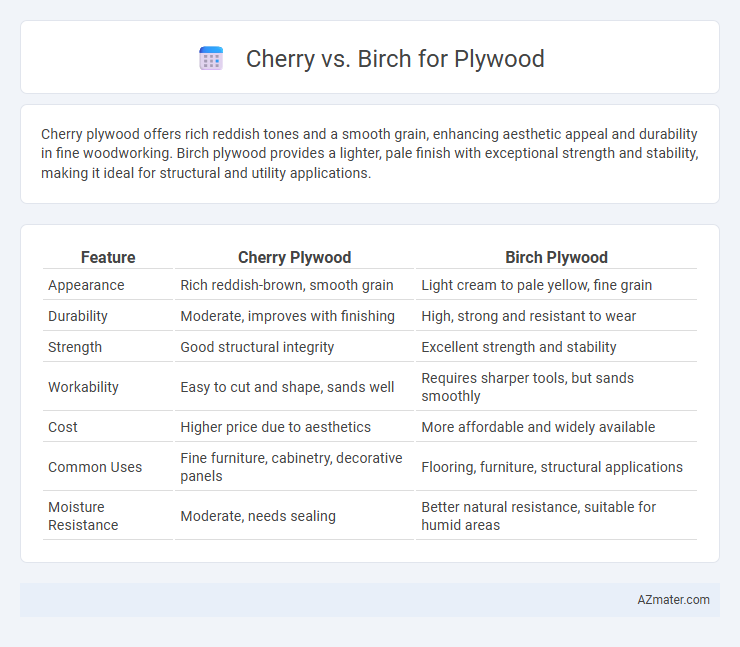Cherry plywood offers rich reddish tones and a smooth grain, enhancing aesthetic appeal and durability in fine woodworking. Birch plywood provides a lighter, pale finish with exceptional strength and stability, making it ideal for structural and utility applications.
Table of Comparison
| Feature | Cherry Plywood | Birch Plywood |
|---|---|---|
| Appearance | Rich reddish-brown, smooth grain | Light cream to pale yellow, fine grain |
| Durability | Moderate, improves with finishing | High, strong and resistant to wear |
| Strength | Good structural integrity | Excellent strength and stability |
| Workability | Easy to cut and shape, sands well | Requires sharper tools, but sands smoothly |
| Cost | Higher price due to aesthetics | More affordable and widely available |
| Common Uses | Fine furniture, cabinetry, decorative panels | Flooring, furniture, structural applications |
| Moisture Resistance | Moderate, needs sealing | Better natural resistance, suitable for humid areas |
Introduction to Cherry vs Birch Plywood
Cherry plywood offers a rich, warm reddish-brown finish and fine grain, making it ideal for high-end furniture and cabinetry requiring aesthetic appeal. Birch plywood provides a lighter, more uniform appearance with exceptional strength and durability, commonly used in construction, cabinetry, and industrial applications. Both materials feature multi-layered veneers bonded with strong adhesives, but cherry plywood prioritizes beauty while birch plywood emphasizes structural integrity.
Overview of Cherry and Birch Wood Species
Cherry plywood is prized for its rich, reddish-brown hue and smooth grain, offering excellent workability and a warm, elegant finish ideal for fine furniture and cabinetry. Birch plywood, known for its pale, creamy color and fine, uniform texture, provides superior strength and durability with a smooth surface that accepts paint and stains well. Both species deliver high-quality plywood options, with cherry favored for aesthetic appeal and birch preferred for structural applications.
Appearance and Grain Patterns
Cherry plywood features a warm reddish-brown hue with smooth, fine grain patterns that darken gracefully over time, offering a rich and elegant aesthetic. Birch plywood presents a lighter, creamy color with a uniform, straight grain that provides a clean, modern look ideal for minimalist designs. Both woods showcase distinct grain characteristics that influence the visual appeal and style of cabinetry, furniture, and interior applications.
Strength and Durability Comparison
Cherry plywood offers moderate strength with a fine, smooth texture ideal for aesthetic applications, while birch plywood is known for its exceptional strength and superior durability, making it suitable for heavy-duty construction and furniture. Birch plywood has a higher resistance to warping and impact due to its dense grain structure, outperforming cherry in long-term structural integrity. The durability of birch plywood also translates to better wear resistance, ensuring prolonged lifespan in demanding environments compared to the relatively softer cherry plywood.
Workability and Machining Differences
Cherry plywood offers excellent workability due to its fine, uniform grain and moderate hardness, allowing smooth sanding and finishing with minimal effort. Birch plywood is harder and denser, making it more durable but slightly more challenging to machine, often requiring sharper tools to achieve clean cuts and precise edges. Both woods respond well to common woodworking tools, but cherry's softer nature reduces wear on blades and facilitates intricate detailing compared to birch.
Cost and Availability Factors
Cherry plywood generally has higher costs due to its limited availability and premium aesthetic qualities, making it a more expensive choice for woodworking projects. Birch plywood is more widely available and offers a cost-effective alternative with good strength and a smooth surface, often favored in both commercial and DIY applications. The price difference is substantial, with birch typically costing 30-50% less than cherry, reflecting its abundance and easier sourcing.
Finishing and Staining Characteristics
Cherry plywood offers a smooth, fine-grained surface that takes stain evenly, enhancing its natural reddish-brown tones and deepening its rich, warm appearance over time. Birch plywood has a tighter grain pattern and a lighter color, which makes it more versatile for staining, allowing for a variety of finishes from light natural looks to darker, more dramatic tones. Both woods respond well to sanding and finishing, but cherry's inherent color often requires less staining to achieve a high-quality, polished look compared to birch, which often benefits from a pre-stain conditioner for more uniform results.
Common Applications in Woodworking
Cherry plywood is preferred for fine furniture, cabinetry, and decorative accents due to its rich reddish-brown color and smooth grain that enhances aesthetic appeal. Birch plywood offers superior strength and durability, making it ideal for structural projects, flooring, and utility furniture where stability and resistance to wear are critical. Both materials are favored in woodworking, with cherry emphasizing visual elegance and birch delivering robust performance.
Environmental Impact and Sustainability
Cherry plywood is less commonly used but offers moderate sustainability due to its slower growth rate and lower replanting rates compared to birch. Birch plywood is often considered more environmentally friendly because birch trees grow rapidly and are typically sourced from well-managed, renewable forests, ensuring better carbon sequestration and reduced deforestation impact. Sustainable certifications like FSC often favor birch plywood, making it a more eco-conscious choice in construction and woodworking projects focused on minimizing environmental footprint.
Choosing the Right Plywood for Your Project
Cherry plywood offers a rich, warm hue and fine grain, making it ideal for high-end furniture and decorative cabinetry where appearance is paramount. Birch plywood boasts exceptional strength, durability, and a smooth, light finish, suitable for structural applications, shelving, and functional furniture requiring robustness. Selecting between cherry and birch plywood depends on balancing aesthetic appeal with mechanical performance tailored to your project's specific requirements.

Infographic: Cherry vs Birch for Plywood
 azmater.com
azmater.com